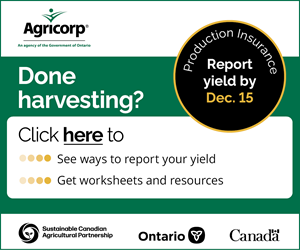GFO Newsletter for February 2015
GET THE LATEST NEWS FROM GRAIN FARMERS OF ONTARIO
Grain Farmers of Ontario celebrates fifth anniversary
Grain Farmers of Ontario celebrated its fifth anniversary this January. The organization officially formed in 2010 with the amalgamation of the Ontario Corn Producer’s Association, the Ontario Soybean Growers, and the Ontario Wheat Producers’ Marketing Board. The anniversary was marked with a cake shared by the Board of Directors and staff members ahead of the January District Grain Committee Meetings. Read more about this milestone in Barry Senft’s CEO update on page four. •
Barley and oats to be represented by Grain Farmers of Ontario
Barley and oat farmers across the province have voted strongly in favour of being represented by Grain Farmers of Ontario. The Ontario Farm Products Marketing Commission invited barley and oat farmers to participate in an expression of opinion vote in November 2014. The result announced in January was very positive with 77% of voters in favour of representation by Grain Farmers of Ontario.
The Ontario Farm Products Marketing Commission has begun the process required to make the regulatory changes. This includes a posting on the government regulatory registry for 45 days to allow additional comments on the addition of barley and oats. The intent is to have all regulatory amendments finalized for July 1, 2015. Under the amended regulations, farmers selling barley and oats to licensed elevators or mills will be required to pay a license fee to Grain Farmers of Ontario. Farm fed and farmer to farmer sales of barley and oats will not attract any licence fees, which is consistent with the current treatment of corn, soybeans, and wheat. View the regulation posting. •
Pollinator Taskforce
Grain Farmers of Ontario is working with an industry- led Pollinator Taskforce to help protect pollinators and ensure the continued availability of neonicotinoid treated seed. The taskforce also includes the Independent Commercial Beekeepers, Ontario Agri Business Association, Canadian Seed Trade Association, and Certified Crop Advisors.
Grain Farmers of Ontario had an agreement with the Ontario government to put together a taskforce but they walked away from the table and instead published proposed regulations that are unwarranted and unworkable.
The Taskforce will look at five main areas: habitat, alternative pesticides/genetics for farmers and beekeepers, research (metrics for determining bee/ pollinator health, environmental data), education between beekeepers and farmers, and risk reduction (including the use of Best Management Practices, polymer coatings, and deflectors).
Grain Farmers of Ontario consulted with farmer-members at the January district meetings and updated them on what the Taskforce has learned so far. These findings and our commitment to the safe use of neonicotinoids will be presented to the Ontario government in 2015 with the hopes that sound judgement prevails. •
Market Commentary
by Philip Shaw
The United States Department of Agriculture’s (USDA’s) January 12 final crop production report was reflective of the great year in U.S. production fields. Final U.S. corn yield was pegged at 171 bushels per acre, yielding a crop of 14.216 billion bushels off 83.1 million acres. Soybean yields were also increased with the USDA pegging yield at 47.8 bushels per acre off 83.1 million acres for a crop size of 3.969 billion. USDA’s wheat ending stocks also increased.
In Ontario, U.S. corn continues to be imported which reflects disappointing crop yields and quality from last fall. Basis levels have reflected this with a +55 over March in southwestern Ontario and +90 over the March futures in Eastern Ontario. The Canadian dollar, at .8367 on January 12, is aiding this. •






















